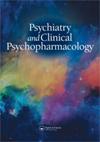第十一届国际精神药理学大会暨第七届儿童与青少年精神药理学国际研讨会
IF 0.5
4区 医学
Q4 PHARMACOLOGY & PHARMACY
引用次数: 1
摘要
目的:现有证据表明,双相情感障碍的主要病理过程和情绪发作的潜在有害影响与障碍活动和情绪状态的变化密切相关。虽然有一些研究表明这种关系的存在,但结果是矛盾的。炎症变化发生在双相情感障碍(BD) 1型的各种发作中。这些变化可被认为是该疾病的外围症状。在本研究中,我们旨在比较躁狂期、抑郁期和平静期BD患者与健康对照组的炎症生物标志物。方法:对78例健康对照和108例BD患者进行白细胞介素(IL)和肿瘤坏死因子(TNF)测定,并进行比较。结果:患者与对照组在年龄(p = 0.040)、文化程度(p = 0.002)方面差异有统计学意义。两组患者在发病年龄(p = 0.862)、病程(p = 0.389)、住院年龄(p = 0.092)等临床变量上无统计学差异。在躁狂亚组中,精神科住院率高于抑郁症或其他亚组(p = 0.047)。外周血标志物(IL-2、IL-4、IL-8、IL-10、TNFα)与对照组比较,外周血标志物与对照组比较差异均无统计学意义。对照组il - 10水平高于BD组,但差异无统计学意义。结论:结果,两组比较BD组与对照组血清基础IL、TNF浓度差异无统计学意义。患者组间比较无差异。IL-2、IL-4与躁狂发作时IL-2的差异无统计学意义。因此,为了阐明BD中炎症生物标志物之间的关系及其与药物治疗的可能关联,需要在更大的患者样本中进行生物标志物测量,最好是在不同的情绪阶段,甚至在同一发作的不同时间。本文章由计算机程序翻译,如有差异,请以英文原文为准。
11th International Congress on Psychopharmacology & 7th International Symposium on Child and Adolescent Psychopharmacology
OBJECTIVE: The available evidence suggests that the main pathological processes underlying Bipolar Disorder and the potential harmful effects of mood episodes are closely related to changes in disorder activity and mood status. Although there are several studies on the existence of a relationship, the results are contradictory. Inflammatory changes occur in various episodes of Bipolar Disorder (BD) Type 1. These changes can be considered as peripheral symptoms of the disorder. In this study, we aimed to compare the inflammatory biomarkers in the BD patients in the manic, depressive and euthymic period with the healthy controls. METHODS: Interleukins (IL) and tumour necrosis factor (TNF) values were measured and compared in 78 healthy controls with 108 patients with BD. RESULTS: There was a statistically significant difference between the patient and control groups in terms of age (p = .040) and educational status (p = .002). There were no statistically significant differences between the BD subgroups with regard to clinical variables such as the age of onset (p = .862), duration of disease (p = .389) and the age of hospitalization (p = .092). In the subgroup of mania, the rate of psychiatric hospitalization was higher than depression or other subgroups (p = .047). When the blood values of peripheral biomarkers (IL-2, IL-4, IL-8, IL-10 and TNFα) were compared, there was no statistically significant difference between the values of the peripheral biomarkers of all BD patients and the control group. The levels of IL10 were higher in the control group than in the BD group, but not statistically significant. CONCLUSIONS: As a result, there was no statistically significant difference between the two groups when comparing serum concentrations of basic IL and TNF in the BD group and control group. There was no difference in the comparison among the patient groups. IL-2 and IL-4 and manic episodes of IL-2 in manic episode were not significant. Therefore, in order to clarify the relationship between inflammatory biomarkers in BD and its possible association with pharmacological treatments, biomarker measurements are required in larger patient samples and ideally at different mood stages and even at different times of the same attack.
求助全文
通过发布文献求助,成功后即可免费获取论文全文。
去求助
来源期刊

Psychiatry and Clinical Psychopharmacology
Medicine-Psychiatry and Mental Health
CiteScore
1.00
自引率
14.30%
发文量
0
期刊介绍:
Psychiatry and Clinical Psychopharmacology aims to reach a national and international audience and will accept submissions from authors worldwide. It gives high priority to original studies of interest to clinicians and scientists in applied and basic neurosciences and related disciplines. Psychiatry and Clinical Psychopharmacology publishes high quality research targeted to specialists, residents and scientists in psychiatry, psychology, neurology, pharmacology, molecular biology, genetics, physiology, neurochemistry, and related sciences.
 求助内容:
求助内容: 应助结果提醒方式:
应助结果提醒方式:


